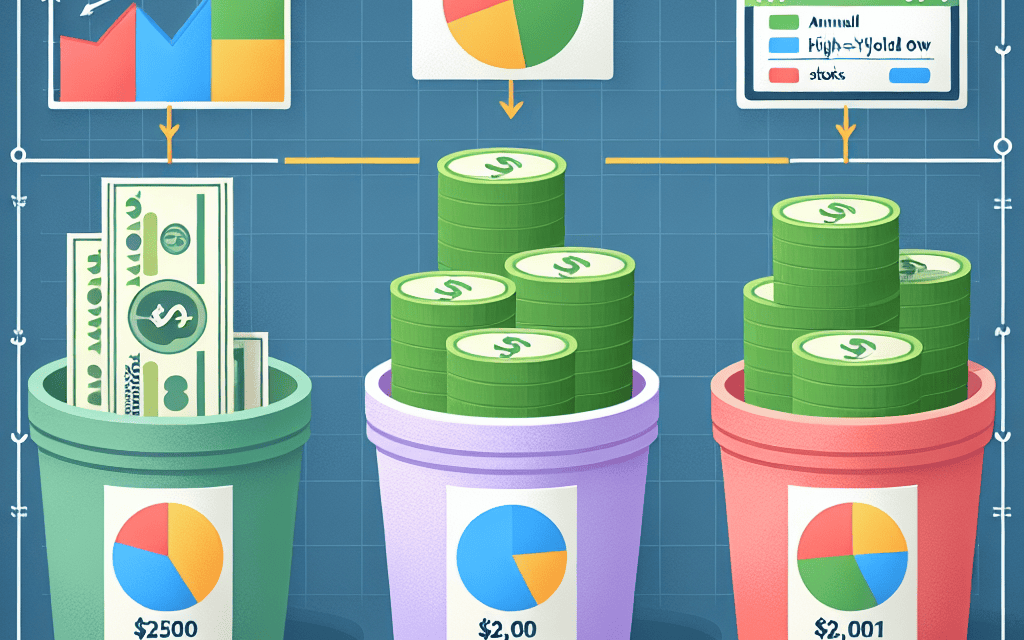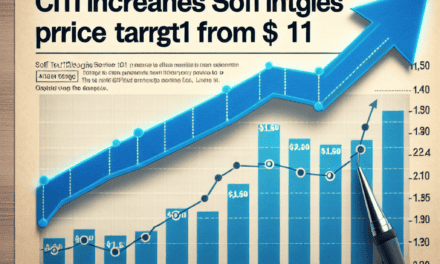“Turn $2,500 into $300+ Annual Income with These High-Yield Dow Stocks!”
Introduction
Investing in high-yield stocks is a strategic approach to generating consistent passive income, and the Dow Jones Industrial Average offers a selection of robust companies with attractive dividend yields. By allocating $2,500 across three carefully chosen Dow stocks, investors can potentially secure an annual passive income exceeding $300. This strategy not only leverages the stability and reputation of established blue-chip companies but also capitalizes on their commitment to returning value to shareholders through dividends. In this article, we explore three high-yield Dow stocks that present compelling opportunities for income-focused investors seeking to enhance their financial portfolios with reliable dividend payouts.
Understanding High-Yield Dow Stocks: A Beginner’s Guide
Investing in high-yield Dow stocks can be an effective strategy for generating passive income, especially for those new to the world of investing. The Dow Jones Industrial Average, often referred to simply as “the Dow,” is a stock market index that tracks 30 large, publicly-owned companies based in the United States. These companies are leaders in their respective industries and are known for their stability and consistent performance. For beginners, investing in high-yield Dow stocks offers a combination of reliability and income potential, making it an attractive option for those looking to build a steady stream of passive income.
To begin with, it is important to understand what is meant by “high-yield” stocks. In the context of the stock market, yield refers to the income return on an investment, typically expressed as a percentage. High-yield stocks are those that offer a higher dividend yield compared to the average yield of the market. Dividends are portions of a company’s earnings that are distributed to shareholders, usually on a quarterly basis. By investing in high-yield stocks, investors can earn regular income in the form of dividends, which can be particularly appealing for those seeking to supplement their income without actively managing their investments.
When considering which high-yield Dow stocks to invest in, it is crucial to evaluate the financial health and dividend history of the companies in question. Companies with a strong track record of paying and increasing dividends are generally more reliable and less risky. For instance, companies like Verizon Communications, Chevron, and IBM have historically offered attractive dividend yields and have demonstrated resilience in various market conditions. By investing $2,500 across these three stocks, investors can potentially earn over $300 in annual passive income, assuming the dividend yields remain consistent.
Verizon Communications, a leading telecommunications company, has long been a favorite among income-focused investors due to its robust dividend yield. The company’s stable cash flow and strong market position make it a reliable choice for those seeking consistent dividend payments. Similarly, Chevron, a major player in the energy sector, offers an appealing dividend yield, supported by its diversified operations and strategic investments in renewable energy. As the world continues to transition towards cleaner energy sources, Chevron’s adaptability and commitment to sustainability may further enhance its long-term growth prospects.
IBM, a technology giant, also presents an attractive opportunity for dividend-seeking investors. Despite facing challenges in recent years, IBM has maintained its dividend payments and is actively working to transform its business model through strategic acquisitions and a focus on cloud computing and artificial intelligence. This commitment to innovation, coupled with its strong dividend yield, makes IBM a compelling choice for those looking to invest in high-yield Dow stocks.
In conclusion, investing in high-yield Dow stocks can be a prudent strategy for beginners seeking to generate passive income. By carefully selecting companies with strong financial health and a history of reliable dividend payments, investors can build a diversified portfolio that offers both stability and income potential. With an investment of $2,500 in Verizon Communications, Chevron, and IBM, individuals can potentially earn over $300 in annual passive income, providing a solid foundation for future financial growth. As always, it is important to conduct thorough research and consider one’s own financial goals and risk tolerance before making any investment decisions.
The Benefits of Investing in High-Yield Stocks for Passive Income
Investing in high-yield stocks is a strategic approach for those seeking to generate passive income, and the Dow Jones Industrial Average offers a selection of robust options. By allocating $2,500 into carefully chosen high-yield Dow stocks, investors can potentially secure an annual passive income exceeding $300. This strategy not only provides a steady income stream but also offers the potential for capital appreciation over time. As we delve into the benefits of investing in high-yield stocks, it is essential to understand the underlying principles that make this approach appealing to both novice and seasoned investors.
To begin with, high-yield stocks are typically associated with established companies that have a history of stable earnings and consistent dividend payments. These companies, often leaders in their respective industries, are less volatile compared to their growth-oriented counterparts. Consequently, they offer a degree of financial security, which is particularly attractive in uncertain economic climates. By investing in such stocks, individuals can benefit from regular dividend payments, which serve as a reliable source of passive income. This income can be reinvested to purchase additional shares, thereby compounding returns over time, or it can be used to supplement other income sources.
Moreover, the Dow Jones Industrial Average, a renowned index comprising 30 prominent companies, includes several high-yield stocks that are well-suited for income-focused investors. These companies have demonstrated resilience and adaptability, maintaining their dividend payouts even during economic downturns. By selecting stocks from this index, investors can tap into the stability and growth potential of some of the most reputable firms in the world. This not only enhances the likelihood of receiving consistent dividends but also reduces the risk associated with investing in less established entities.
In addition to providing a steady income stream, high-yield stocks offer the potential for capital appreciation. As these companies continue to grow and expand their operations, their stock prices may increase, leading to capital gains for investors. This dual benefit of income and growth makes high-yield stocks an attractive option for those looking to build wealth over the long term. Furthermore, the reinvestment of dividends can accelerate this growth, as it allows investors to acquire more shares without additional capital outlay.
Transitioning to the practical aspect of this investment strategy, it is crucial to conduct thorough research and analysis before selecting specific stocks. Factors such as dividend yield, payout ratio, and the company’s financial health should be carefully evaluated to ensure that the chosen stocks align with the investor’s income goals and risk tolerance. Additionally, diversification across different sectors can mitigate risks and enhance the overall stability of the investment portfolio.
In conclusion, investing $2,500 in high-yield Dow stocks can be a prudent decision for those seeking to generate over $300 in annual passive income. This approach not only provides a reliable income stream but also offers the potential for capital appreciation, making it a compelling option for long-term wealth accumulation. By carefully selecting and diversifying investments within the Dow Jones Industrial Average, investors can enjoy the benefits of financial stability and growth, ultimately achieving their passive income objectives.
How to Choose the Right Dow Stocks for Your Investment Portfolio
When considering an investment strategy that focuses on generating passive income, selecting the right stocks is crucial. The Dow Jones Industrial Average (DJIA), a prominent stock market index, comprises 30 significant publicly traded companies in the United States. These companies are often leaders in their respective industries, making them attractive options for investors seeking stability and reliable returns. For those looking to invest $2,500 with the goal of earning over $300 annually in passive income, focusing on high-yield Dow stocks can be a prudent approach.
To begin with, it is essential to understand what constitutes a high-yield stock. Typically, these are stocks that offer a dividend yield higher than the average yield of the market. Dividends are portions of a company’s earnings distributed to shareholders, and a higher yield indicates a greater return on investment relative to the stock’s price. When selecting Dow stocks for your portfolio, it is important to consider not only the yield but also the company’s financial health and dividend history. A consistent track record of dividend payments and increases can be a strong indicator of a company’s commitment to returning value to shareholders.
One of the first steps in choosing the right Dow stocks is to conduct thorough research on each company’s financial performance. This includes analyzing their earnings reports, balance sheets, and cash flow statements. Companies with strong financials are more likely to sustain and grow their dividend payments over time. Additionally, it is beneficial to examine the industry in which the company operates. Industries with stable demand and growth potential, such as consumer goods or healthcare, often provide a more secure environment for dividend-paying stocks.
Moreover, diversification is a key principle in building a resilient investment portfolio. By selecting stocks from different sectors within the Dow, investors can mitigate risks associated with economic downturns that may affect specific industries. For instance, combining stocks from the technology, healthcare, and consumer goods sectors can provide a balanced mix of growth potential and income stability. This approach not only enhances the potential for passive income but also reduces the impact of market volatility on the overall portfolio.
In addition to diversification, it is important to consider the payout ratio of each stock. The payout ratio is the percentage of earnings a company pays out as dividends. A lower payout ratio suggests that a company retains more of its earnings for growth and expansion, which can be a positive sign for future dividend increases. Conversely, a very high payout ratio may indicate that a company is overextending itself to maintain its dividend, which could be unsustainable in the long term.
Finally, while high-yield stocks can be attractive for generating passive income, it is crucial to align your investment choices with your overall financial goals and risk tolerance. High yields often come with higher risks, and it is important to balance the desire for income with the need for capital preservation. By carefully selecting Dow stocks that offer a combination of high yield, financial stability, and growth potential, investors can create a portfolio that not only meets their income objectives but also supports long-term wealth accumulation. Through diligent research and strategic diversification, investing $2,500 in the right high-yield Dow stocks can indeed yield over $300 in annual passive income, contributing to a more secure financial future.
Maximizing Returns: Strategies for Investing $2,500 in Dow Stocks

Investing in the stock market can be a rewarding endeavor, particularly when focusing on high-yield stocks that offer the potential for substantial passive income. For those looking to invest $2,500, the Dow Jones Industrial Average presents a selection of robust companies with a history of reliable dividends. By strategically selecting high-yield stocks within this index, investors can aim to generate over $300 in annual passive income. This approach not only maximizes returns but also provides a steady income stream, which can be particularly appealing in uncertain economic times.
To begin with, it is essential to understand the significance of dividend yield when selecting stocks. Dividend yield is a financial ratio that indicates how much a company pays out in dividends each year relative to its stock price. A higher yield often suggests that a company is returning a significant portion of its profits to shareholders, making it an attractive option for income-focused investors. However, it is crucial to balance yield with the stability and growth potential of the company to ensure a sustainable investment.
One of the top contenders in the Dow for high-yield dividends is Verizon Communications Inc. With a yield consistently above 5%, Verizon offers a compelling case for income-seeking investors. The telecommunications giant has a strong market position and a reliable cash flow, which supports its ability to maintain and potentially increase its dividend payouts. Investing a portion of the $2,500 in Verizon could provide a solid foundation for generating passive income.
Transitioning to another promising option, Chevron Corporation stands out with its attractive dividend yield. As one of the leading energy companies, Chevron benefits from its diversified operations and global presence. Despite the volatility often associated with the energy sector, Chevron has demonstrated resilience and a commitment to returning value to shareholders through dividends. By allocating funds to Chevron, investors can tap into the energy sector’s potential while enjoying a steady income stream.
Furthermore, another noteworthy stock to consider is IBM Corporation. Known for its technological innovations and enterprise solutions, IBM offers a dividend yield that appeals to income investors. The company’s strategic focus on cloud computing and artificial intelligence positions it well for future growth, which could enhance its ability to sustain dividend payments. Including IBM in the investment portfolio not only diversifies the holdings but also aligns with the technological advancements shaping the future.
In conclusion, investing $2,500 in a combination of Verizon, Chevron, and IBM can potentially yield over $300 in annual passive income. This strategy leverages the strengths of each company while balancing risk and reward. By focusing on high-yield Dow stocks, investors can benefit from the stability and reputation of established companies, ensuring a reliable income stream. As with any investment decision, it is advisable to conduct thorough research and consider individual financial goals and risk tolerance. By doing so, investors can make informed choices that align with their objectives, ultimately maximizing returns and achieving financial growth.
The Power of Compound Interest: Growing Your Passive Income Over Time
Investing in high-yield stocks is a strategic approach to generating passive income, and when combined with the power of compound interest, it can significantly enhance your financial growth over time. By allocating $2,500 into select high-yield Dow stocks, investors can potentially earn over $300 annually in passive income. This strategy not only provides immediate returns but also sets the stage for long-term financial benefits.
To begin with, the concept of compound interest plays a crucial role in maximizing the returns from high-yield investments. Compound interest refers to the process where the earnings from an investment are reinvested to generate additional earnings over time. This creates a snowball effect, where the investment grows at an accelerating rate. When dividends from high-yield stocks are reinvested, they contribute to the principal amount, which in turn generates more dividends. This cycle continues, leading to exponential growth in the value of the investment.
Among the Dow stocks, there are three that stand out for their high yields and potential for consistent dividend payments. These stocks not only offer attractive yields but also have a history of stable financial performance, making them reliable choices for income-focused investors. By investing in these stocks, one can leverage their high dividend yields to generate a steady stream of passive income.
The first stock to consider is Verizon Communications Inc. Known for its robust dividend yield, Verizon has consistently provided investors with reliable income. The company’s strong market position in the telecommunications industry and its commitment to returning value to shareholders make it an appealing choice for those seeking stable dividends. By reinvesting the dividends received from Verizon, investors can take advantage of compound interest to grow their income over time.
Next, Chevron Corporation offers another compelling opportunity for high-yield investment. As a leading player in the energy sector, Chevron has demonstrated resilience and adaptability in a volatile market. Its commitment to maintaining a strong dividend policy, even during challenging economic conditions, underscores its reliability as a dividend-paying stock. By including Chevron in a diversified portfolio, investors can benefit from its attractive yield and the potential for capital appreciation.
Finally, The Coca-Cola Company presents a unique blend of stability and growth potential. With its iconic brand and global reach, Coca-Cola has consistently delivered dividends to its shareholders. The company’s ability to adapt to changing consumer preferences and its focus on innovation ensure its continued relevance in the market. By investing in Coca-Cola, investors can enjoy a steady income stream while benefiting from the company’s long-term growth prospects.
In conclusion, investing $2,500 in these three high-yield Dow stocks can generate over $300 in annual passive income, providing a solid foundation for financial growth. By reinvesting dividends and harnessing the power of compound interest, investors can significantly enhance their returns over time. This strategy not only offers immediate income but also paves the way for long-term wealth accumulation. As with any investment, it is essential to conduct thorough research and consider one’s financial goals and risk tolerance before making investment decisions. However, with careful planning and a focus on high-yield stocks, investors can effectively leverage the power of compound interest to grow their passive income and achieve financial success.
Risk Management: Safeguarding Your Investment in High-Yield Stocks
Investing in high-yield stocks can be an attractive strategy for generating passive income, especially when considering the potential returns from established companies within the Dow Jones Industrial Average. However, while the allure of high yields is undeniable, it is crucial to approach such investments with a robust risk management strategy to safeguard your capital. By investing $2,500 in a carefully selected trio of high-yield Dow stocks, you can potentially earn over $300 in annual passive income. Yet, understanding and mitigating the associated risks is essential to ensure the sustainability of your investment.
To begin with, diversification is a fundamental principle in risk management. By spreading your investment across multiple stocks, you reduce the impact of any single company’s poor performance on your overall portfolio. In the context of high-yield Dow stocks, selecting companies from different sectors can provide a buffer against sector-specific downturns. For instance, combining a stock from the financial sector with one from the healthcare sector and another from consumer goods can help balance the risks associated with economic cycles and industry-specific challenges.
Moreover, it is important to assess the financial health and dividend sustainability of the companies you choose. High yields can sometimes be a red flag, indicating that a company’s stock price has fallen due to underlying issues. Therefore, conducting thorough research into a company’s earnings, cash flow, and payout ratio is vital. A payout ratio, which measures the proportion of earnings paid out as dividends, should ideally be sustainable, indicating that the company is not overextending itself to maintain high dividend payments. Companies with a history of stable or growing dividends are often more reliable choices for income-focused investors.
In addition to diversification and financial analysis, staying informed about macroeconomic factors is another key aspect of risk management. Economic conditions, interest rates, and geopolitical events can all influence stock performance and dividend yields. For instance, rising interest rates can lead to higher borrowing costs for companies, potentially affecting their profitability and ability to maintain dividend payments. By keeping abreast of such developments, investors can make informed decisions about when to buy, hold, or sell their high-yield stocks.
Furthermore, setting clear investment goals and time horizons can help manage risk. Understanding whether your investment is intended for short-term income generation or long-term growth can influence your stock selection and risk tolerance. For example, if your goal is to generate immediate income, you might prioritize stocks with a higher current yield. Conversely, if you are focused on long-term growth, you might be willing to accept a lower yield in exchange for the potential of capital appreciation.
Lastly, regular portfolio reviews are essential to ensure that your investments continue to align with your risk tolerance and financial objectives. Market conditions and company performance can change, necessitating adjustments to your portfolio. By periodically reassessing your holdings, you can make strategic decisions to rebalance your investments, thereby maintaining an optimal risk-return profile.
In conclusion, while investing $2,500 in high-yield Dow stocks can indeed generate over $300 in annual passive income, it is imperative to implement a comprehensive risk management strategy. Through diversification, financial analysis, awareness of macroeconomic factors, clear investment goals, and regular portfolio reviews, investors can safeguard their investments and enhance the potential for sustainable income.
Real-Life Success Stories: Investors Who Achieved Passive Income Goals
In the realm of investing, the pursuit of passive income is a common goal for many individuals seeking financial independence. Real-life success stories often serve as a beacon of inspiration, demonstrating how strategic investments can yield substantial returns. One such strategy involves investing in high-yield Dow stocks, which have consistently provided investors with reliable dividends. By allocating $2,500 into a carefully selected trio of these stocks, investors can potentially generate over $300 in annual passive income, showcasing a practical approach to achieving financial goals.
Consider the case of Emily, a diligent investor who meticulously researched the Dow Jones Industrial Average, seeking stocks with a history of robust dividend payouts. Her strategy was to identify companies with a strong track record of financial stability and consistent dividend growth. Emily’s investment journey began with a focus on three high-yield Dow stocks: Chevron Corporation, Verizon Communications, and IBM. Each of these companies not only offered attractive dividend yields but also demonstrated resilience in various market conditions.
Chevron Corporation, a leader in the energy sector, has long been a favorite among dividend investors. With its substantial dividend yield, Chevron provided Emily with a steady stream of income, even during periods of market volatility. The company’s commitment to returning capital to shareholders through dividends made it an appealing choice for those seeking passive income. Moreover, Chevron’s strategic investments in renewable energy signaled a forward-thinking approach, ensuring its relevance in a rapidly evolving industry.
Similarly, Verizon Communications stood out as a telecommunications giant with a reputation for delivering reliable dividends. Emily recognized the essential nature of telecommunications services, which provided a stable revenue stream for the company. Verizon’s focus on expanding its 5G network and enhancing its digital infrastructure further solidified its position as a leader in the industry. For Emily, investing in Verizon meant tapping into a company with a strong market presence and a commitment to rewarding its shareholders.
IBM, a stalwart in the technology sector, completed Emily’s trio of high-yield Dow stocks. Known for its innovation and adaptability, IBM has consistently paid dividends, making it an attractive option for income-focused investors. The company’s strategic pivot towards cloud computing and artificial intelligence demonstrated its ability to evolve with technological advancements. Emily appreciated IBM’s dedication to maintaining its dividend policy while investing in future growth opportunities, providing her with both income and potential capital appreciation.
By investing $2,500 across these three high-yield Dow stocks, Emily was able to generate over $300 in annual passive income. This achievement not only underscored the power of dividend investing but also highlighted the importance of selecting companies with a proven track record of financial performance. Emily’s success story serves as a testament to the potential of strategic stock selection in achieving passive income goals.
In conclusion, the journey to financial independence through passive income is attainable with careful planning and informed decision-making. By investing in high-yield Dow stocks like Chevron, Verizon, and IBM, individuals can create a reliable income stream that contributes to their financial well-being. Emily’s story exemplifies how a thoughtful approach to investing can lead to tangible results, inspiring others to embark on their own path towards achieving passive income goals.
Q&A
1. **What is the main focus of the investment strategy?**
Investing $2,500 in high-yield Dow stocks to generate over $300 in annual passive income.
2. **What are high-yield stocks?**
High-yield stocks are shares of companies that pay higher-than-average dividends compared to other stocks.
3. **Why choose Dow stocks for this strategy?**
Dow stocks are typically large, established companies with a history of stable earnings and reliable dividend payments.
4. **How much annual income is expected from this investment?**
The investment aims to generate over $300 in annual passive income.
5. **What is the average yield required to achieve $300 annual income from a $2,500 investment?**
An average yield of approximately 12% is required to achieve $300 annual income from a $2,500 investment.
6. **What are the benefits of investing in dividend stocks?**
Dividend stocks provide regular income, potential for capital appreciation, and can offer a hedge against inflation.
7. **What should investors consider when selecting high-yield stocks?**
Investors should consider the company’s financial health, dividend history, payout ratio, and overall market conditions.
Conclusion
Investing $2,500 in high-yield Dow stocks can be a strategic move for generating passive income. By selecting stocks with robust dividend yields, investors can potentially earn over $300 annually. This approach not only provides a steady income stream but also offers the potential for capital appreciation over time. However, it’s essential to consider the risks associated with stock market investments, including market volatility and changes in dividend policies. Diversifying investments and conducting thorough research on each stock’s financial health and market position can help mitigate these risks and enhance the potential for long-term financial growth.





